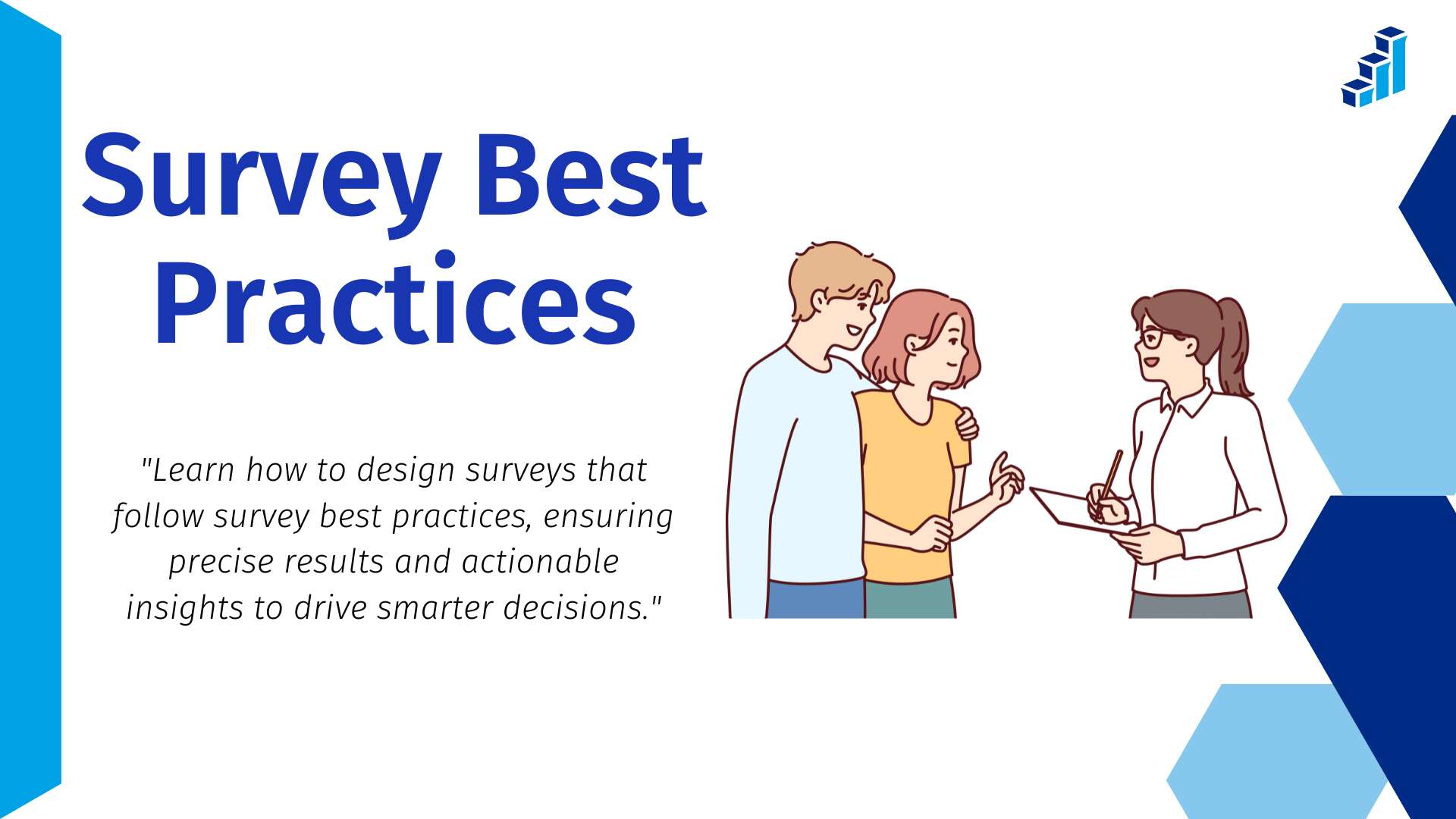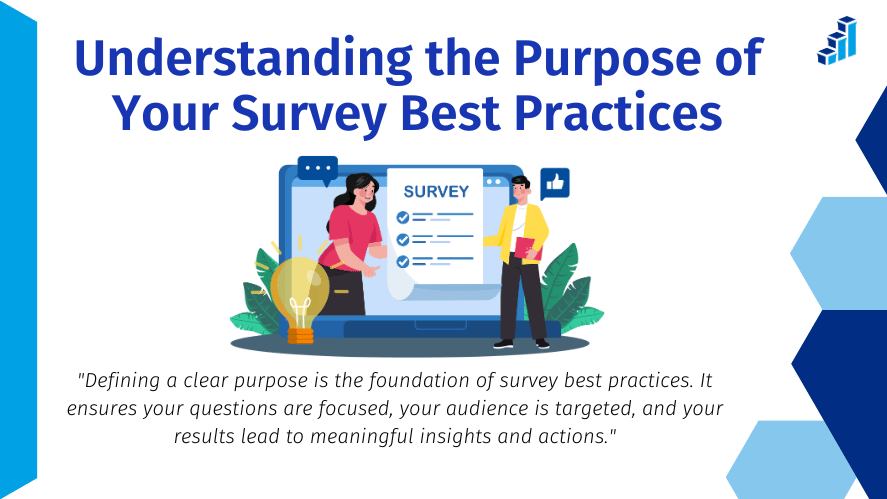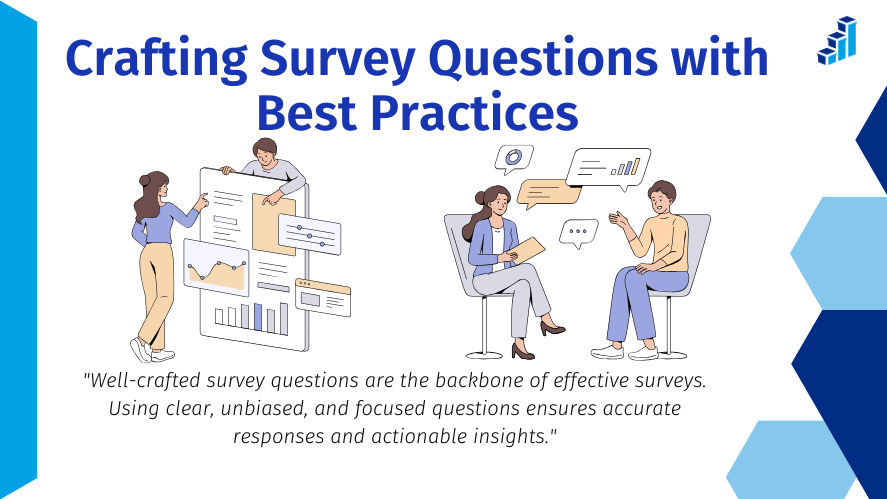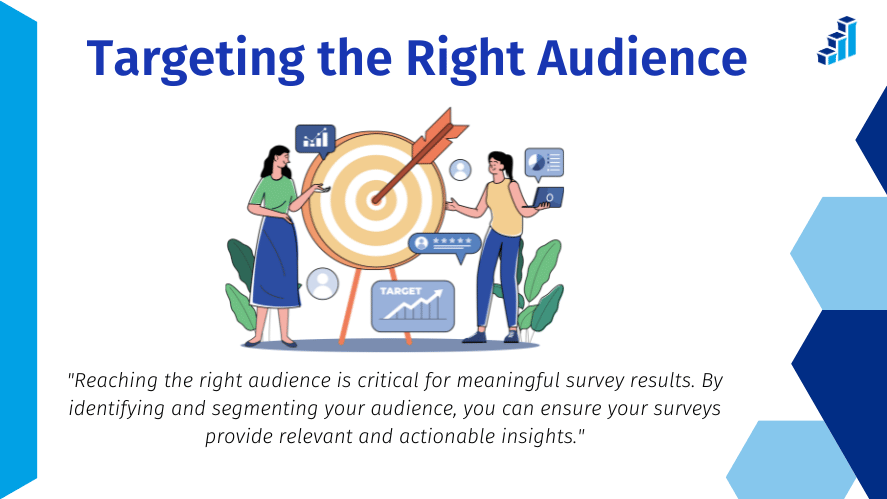
Survey Best Practices: How to Get Accurate and Actionable Data
Surveys are powerful tools for collecting data, understanding your audience, and making better decisions. However, creating a great survey isn’t just about asking questions. By following survey best practices, you can design surveys that get higher response rates, more reliable data, and insights that you can act on. Whether you’re creating an NPS survey or learning how to design a survey, this guide will help you succeed.
Understanding the Purpose of Your Survey Best Practices

To design a great survey, you first need to understand what is a survey and why a clear purpose is so important. A survey is a tool to gather opinions, preferences, or feedback from a group of people. One big concern when designing a survey is a lack of focus, which can lead to poor results.
Why Clear Objectives Matter
Your survey’s purpose should answer three questions:
- What do you want to learn? For example, are you trying to measure customer satisfaction or get employee feedback?
- Who is your audience? Reaching the right people ensures meaningful results.
- How will you use the data? Every survey should lead to specific actions or decisions.
Examples of Clear Goals:
- Learn how customers feel about a new product.
- Measure employee happiness and engagement.
- Find out how well a marketing campaign worked.
Without clear goals, your survey can feel confusing or pointless. Tools like Polling.com can help you define your objectives and structure your survey to achieve them.
Survey Best Practices for Choosing the Right Format
Picking the right type of survey is just as important as asking the right questions. If the format doesn’t match your purpose, you might get poor data or low response rates.
Types of Surveys
- Online Surveys: Quick and easy to distribute. Ideal for wide audiences.
- NPS Surveys: Measure customer loyalty by asking how likely they are to recommend you.
- Customer Satisfaction Surveys: Assess how happy customers are with your product or service.
- Employee Engagement Surveys: Check how satisfied and motivated employees feel at work.
How to Choose the Right Format
To select the best type of survey, ask yourself:
- What does my audience prefer? For example, older respondents may prefer email, while younger audiences like social media surveys.
- What type of data do I need? Quantitative surveys work well for numbers, while qualitative ones capture detailed feedback.
- What’s the best way to reach my audience? Match your survey format to the way your audience engages with you, whether online, in-person, or via email.
Polling.com’s customizable survey templates make it easy to choose and create the right format.
Crafting Effective Survey Questions with Best Practices

Asking clear, unbiased questions is one of the most important survey best practices. Well-written questions lead to accurate answers, while confusing or biased questions can ruin your results.
How to Write Questions That Follow Survey Best Practices
- Keep Questions Simple: Use short, clear sentences without jargon.
- Bad: “How would you describe your overall experience with the implementation process of our latest software?”
- Better: “How would you rate your experience with our software?”
- Avoid Leading Questions: Don’t suggest an answer.
- Bad: “Don’t you think our product is great?”
- Better: “How would you rate your satisfaction with our product?”
- Ask One Thing at a Time: Don’t combine two questions into one.
- Poor example: “How satisfied are you with both our customer service and delivery speed?”
- Better: “How would you rate our customer service?”
- Mix Open and Closed Questions: Use open-ended questions to get detailed feedback and closed questions for quick data.
- Open-ended: “What improvements would you like to see?”
- Closed-ended: “Rate your satisfaction from 1 to 5.”
Examples of Good vs. Poor Questions
Poorly Written QuestionsImproved Versions”Isn’t our app amazing?””What do you think about our app?””How satisfied are you with your job?””How satisfied are you with your current role?”
Tools like Polling.com help you create professional, precise questions to avoid bias and confusion.
Optimizing Survey Length and Flow
The length and flow of your survey play a big role in how many people complete it. A survey that’s too long or confusing can scare people away.
Why Length Matters
Shorter surveys get more responses. If a survey takes more than 10 minutes to complete, people may give up halfway through.
Best Practices for Survey Flow
- Group Similar Questions: Organize your survey so related questions are together.
- Start with Easy Questions: Begin with simple, non-sensitive questions to build confidence.
- Save Demographics for Last: Questions about age, income, or location should go at the end since they can feel intrusive.
Polling.com offers tools to test your survey flow, so you can make adjustments and create a smooth experience.
Targeting the Right Audience

Even the best survey won’t work if the wrong people take it. To get reliable results, you need to reach the right audience.
Steps to Identify Your Audience
- Use Demographic Data: Segment your audience by factors like age, gender, and location.
- Focus on Behavior: Look at actions your audience has already taken, like past purchases or website visits.
- Create Personas: Build profiles of your ideal respondents to guide your targeting strategy.
How to Distribute Your Survey
Here are some effective ways to reach your audience:
- Email: Great for personalized surveys.
- Social Media: Perfect for reaching a large group quickly.
- In-App Surveys: Ideal for active users of your app or software.
Case Study: A retail company using Polling.com segmented their customers based on shopping habits and distributed NPS surveys via email. This led to a 25% increase in response rates compared to previous surveys.
Testing and Refining Your Survey
Testing your survey before launching it is a simple way to catch errors and make sure it works. This step can improve the clarity of your questions and the overall experience for respondents.
How to Test Your Survey
- Run a Pilot Test: Share your survey with a small group of people who represent your target audience.
- Ask for Feedback: Find out if anything was unclear or too long.
- Review the Data: Look at test responses to see if the questions are delivering the insights you need.
Polling.com’s preview and test tools make it easy to refine your survey and fix problems before you launch.
Analyzing Survey Results
Once you’ve collected responses, the final step is analyzing the data. This is where you turn raw feedback into actionable insights.
Steps for Analyzing Data
- Organize Responses: Sort answers by question and demographic.
- Look for Patterns: Identify trends, like common complaints or areas where people are most satisfied.
- Use Visuals: Charts and graphs make it easier to share your results with others.
Avoid These Common Mistakes
- Don’t let confirmation bias affect your results. Look at all the data fairly and don’t focus only on the answers you agree with.
- Make sure your sample size is large enough to draw meaningful conclusions.
With Polling.com’s advanced analytics, you can quickly find insights and create easy-to-understand reports.
Conclusion: Mastering Survey Best Practices
By following these survey best practices, you can design surveys that get better results. From defining your goals to analyzing data, every step matters. Surveys that are clear, focused, and targeted to the right audience can lead to actionable insights and better decisions.
If you’re ready to create high-quality surveys, check out Polling.com. Their tools make it easy to design, test, and analyze surveys for any purpose.
Start creating better surveys today and get the answers you need to succeed!
